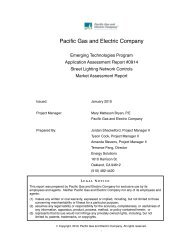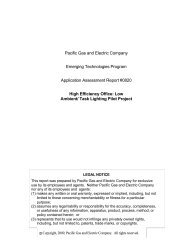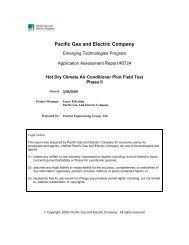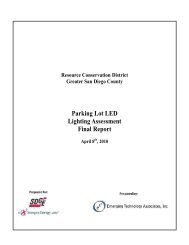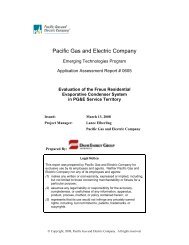Laboratory Evaluation of the OASys Indirect/Direct Evaporative
Laboratory Evaluation of the OASys Indirect/Direct Evaporative
Laboratory Evaluation of the OASys Indirect/Direct Evaporative
You also want an ePaper? Increase the reach of your titles
YUMPU automatically turns print PDFs into web optimized ePapers that Google loves.
60<br />
65<br />
70<br />
Supply: 66°F<br />
Water Reservoir: 69°F<br />
Figure 10: Process Description at one Test Condition<br />
75<br />
Summer<br />
Comfort<br />
Zone<br />
Inter-stage (Meas.): 77°F<br />
Exhaust: 85°F<br />
491-06.12.doc 14<br />
80<br />
85<br />
Inter-stage (Calc.): 92°F<br />
Intake: 110°F<br />
60 65 70 75 80 85 90 95 100 105 110<br />
0.000<br />
115<br />
Dry Bulb Temperature - °F<br />
90%<br />
80%<br />
70%<br />
Wet Bulb Temperature<br />
60%<br />
110% Effectiveness<br />
The results from <strong>the</strong> tests are shown in several tables and figures, <strong>of</strong> which most are located at <strong>the</strong> end <strong>of</strong><br />
<strong>the</strong> report in <strong>the</strong> Appendix. Also in <strong>the</strong> Appendix is a detailed summary <strong>of</strong> all <strong>the</strong> averaged test<br />
measurements and calculated results.<br />
Fixed Inlet Conditions, Variable Outlet Resistance (and Voltage)<br />
For <strong>the</strong> first set <strong>of</strong> tests, <strong>the</strong> intake conditions were maintained constant while <strong>the</strong> supply outlet resistance<br />
and fan speed were varied. The intake condition selected was that used for <strong>the</strong> Title-20 ECER: 91°Fdb /<br />
69°Fwb, even though <strong>the</strong> wet-bulb depression was only 22°F ra<strong>the</strong>r than <strong>the</strong> ASHRAE required 25°F.<br />
One o<strong>the</strong>r variable was <strong>the</strong> position <strong>of</strong> <strong>the</strong> damper on <strong>the</strong> exhaust outlet, which is used to control <strong>the</strong><br />
amount <strong>of</strong> airflow through <strong>the</strong> wet side <strong>of</strong> <strong>the</strong> indirect stage. To observe <strong>the</strong> full range <strong>of</strong> operation, tests<br />
were conducted with this damper in its fully open and fully closed positions. In both cases, a zero static<br />
pressure relative to <strong>the</strong> intake was maintained in <strong>the</strong> duct downstream <strong>of</strong> <strong>the</strong> damper. In <strong>the</strong> fully closed<br />
position, <strong>the</strong> damper does not completely shut <strong>of</strong>f <strong>the</strong> exhaust airflow, but only creates a maximum<br />
restriction. Several charts in <strong>the</strong> Appendix are derived from this first set <strong>of</strong> data.<br />
Figure 12 shows <strong>the</strong> results <strong>of</strong> a special test to see <strong>the</strong> effect <strong>of</strong> varying line voltage, since demand for<br />
cooling typically coincides with periods <strong>of</strong> high electrical demand when <strong>the</strong>re may also be voltage sags.<br />
These tests were conducted during <strong>the</strong> period when <strong>the</strong> exhaust damper was in its closed position, and<br />
were conducted with a supply outlet resistance <strong>of</strong> 0.3 inches <strong>of</strong> water. The results are shown relative to<br />
<strong>the</strong> points taken at a line voltage <strong>of</strong> 115V, and ranged from 95 to 120V. The results show that <strong>the</strong>re is a<br />
decrease in speed, power, and airflow as <strong>the</strong> voltage is decreased, and that <strong>the</strong> effectiveness rises slightly<br />
(most likely in response to <strong>the</strong> lower airflow). Also shown is a calculation <strong>of</strong> <strong>the</strong> Title-20 ECER, which<br />
50%<br />
40%<br />
30%<br />
20%<br />
10%<br />
0.030<br />
0.025<br />
0.020<br />
0.015<br />
0.010<br />
0.005<br />
Humidity Ratio - lb moisture / lb dry air




